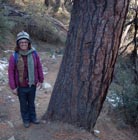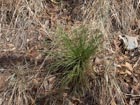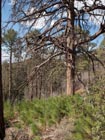Pinus engelmannii
Carrière 1854
Common names
Apache pine, Arizona longleaf pine (Elmore and Janish 1976).
Taxonomic notes
Synonymy:
- Pinus macrophylla Engelmann ex Wislizenus 1848, non Lindley 1839;
- P. latifolia Sargent 1889;
- P. apacheca Lemmon 1894;
- P. mayriana Sudworth 1897;
- P. ponderosa Dougl. ex Laws. var. mayriana (Sudworth) Sargent 1897;
- P. ponderosa Dougl. ex Laws. var. macrophylla (Engelmann) Shaw 1909;
- P. macrophylla Engelm. var. blancoi Martínez 1944; and
- P. engelmannii Carr. var. blancoi (Martínez) Martínez 1948.
Of these synonyms, the only one you are likely to see used is P. engelmannii var. blancoi, nominally distinguished by an increased number of needles per fascicle. Yeaton et al. (1983) showed that the increase, and other foliage metrics, vary clinally as a function of elevation.
This species belongs to Pinus subsection Ponderosae; see the "Taxonomic notes" for Pinus ponderosa for further discussion. Natural hybrids and introgression with other taxa of subsection Ponderosae occur frequently where the taxa co-occur; usually these hybrids involve some combination of P. engelmannii, P. arizonica, and P. scopulorum (Ávila-Flores et al. 2016).
Description
"Trees to 35 m; trunk to 0.6 m diam., straight; crown irregularly rounded, rather thin. Bark dark brown, at maturity deeply furrowed, ridges becoming yellowish, of narrow, elongate, scaly plates. Branches straight to ascending; twigs stout (1-2 cm thick), pale gray-brown, aging darker brown, rough. Buds ovoid-conic, to 2 cm, resinous; scale margins pale fringed. Leaves 3(-5) per fascicle, spreading-ascending, often drooping, forming a brush at twig tips, persisting 2 years, (20-)25-45cm x 2 mm, dull green, all surfaces with fine stomatal lines, margins coarsely serrulate, apex conic-subulate; sheath 3-4 cm, base persistent. Pollen cones cylindric, ca. 25 mm, yellow to yellow-brown. Seed cones maturing in 2 years and shedding seeds soon thereafter, not persistent, terminal, sometimes curved, often asymmetric, lance-ovoid before opening, ovoid when open, 11-14 cm, light dull brown, nearly sessile or short-stalked; apophyses rhombic, somewhat to quite elongate, strongly raised toward outer cone base, sometimes curved, strongly cross-keeled, narrowed to thick, curved, broadly triangular-based umbo, this often producing outcurved claw. Seeds obovoid; body ca. 8-9 mm, dark brown; wing to 20mm. 2n=24" (Kral 1993).
"In general appearance Pinus engelmannii much resembles P. palustris with its short-persistent, long leaves (but in this species drooping) and in its tendency to form a grass stage (see the "Remarks" section of P. devoniana for details on "grass stage" growth). It has a deep taproot as do P. palustris and P. ponderosa" (Kral 1993).
Distribution and Ecology
USA: SE Arizona and SW New Mexico; Mexico: Sonora, Chihuahua, NE Sinaloa, Durango, Zacatecas, Nuevo Leon (Farjon and Styles 1997). It grows at (1200-)1500-2700(-3000) m, in high and dry mountain ranges, valleys, and plateaus (Elmore and Janish 1976, Farjon and Styles 1997). Hardy to Zone 8 (cold hardiness limit between -12.1°C and -6.7°C) (Bannister and Neuner 2001). See also Thompson et al. (1999).
Distribution data from USGS (1999).
Ecologically, this species is something of a western analog to P. palustris, a species of the southeast U.S. coastal plain. Both species have extraordinarily long needles, are dominant species in frequently pure stands, are finely adapted to low-intensity fire with fire frequencies of <5 years, and have "grass stage" seedlings that are highly tolerant of such fires. Even in less frequently burned habitats, it appears that this species is capable of being a very effective competitor in the aftermath of severe fire (photo at right), an observation quite different from that reported by Barton (2002), who found seedlings to be rare after severe fire.
Remarkable Specimens
There are two co-champions growing in Arizona: one is 32.9 m tall and 103 cm dbh, the other is 34.1 m tall and 98 cm dbh (Robert Van Pelt e-mail 2004.02.04).
Ring-counted ages of up to approximately 195 years were found in a silvicultural study in southern Chihuahua (Martínez-Salvador et al. 2013). The oldest known crossdated specimen, 108 years, was documented in a tree-ring chronology covering the period 1908-2015 (crossdated after 1910), collected near Cuchiwachi, Chihuahua, Mexico by M. González-Cásares, M. Pompa-García, and J.J. Camarero (doi.org/10.25921/9xvx-q584). This is the only chronology developed for this species; older trees could certainly be found. This site was used in a study of differences in the climate-growth relationship between pine species of northern Mexico (González-Cásares et al. 2017).
Ethnobotany
I can find no specific records of aboriginal use of the species; most likely, such uses were similar to those made of other hard pine species in the region.
"According to the National Forest Inventory 2004-2009 carried out by the Mexican National Forestry Commission, Apache pine covers an area of about 2,450,000 ha in Mexico; during this period, the mean stand density in the area was 39 trees (diameter > 7 cm at breast height) per hectare, and the maximum density was
794 trees per hectare. Pinus engelmannii is one of the most important timber species in Mexico owing to its valuable wood properties, wide distribution and the large volume of timber that can be harvested. It is widely harvested for lumber and also used in conservation and restoration programmes" (Ávila-Flores et al. 2016, and sources cited therein). The authors add that "P. engelmannii is the second-most important species in nursery production in northwestern Mexico: it is commonly used in reforestation and conservation programmes and, in recent years, also in commercial plantations."
Observations
It can readily be seen in the northern Chiricahua and Santa Rita Mountains (Arizona). In the former, it is common in Chiricahua National Monument. In the latter, it is easily found in Madera Canyon.
Remarks
The epithet honor Georg Engelmann (1809-1884), one of the premier botanists of mid-19th Century America. Engelmann named about 20 western North American conifer taxa.
This species is a principal host for the dwarf mistletoes Arceuthobium globosum subsp. globosum, A. rubrum, A. vaginatum subsp. vaginatum, A. vaginatum subsp. cryptopodum, and A. verticilliflorum (Hawksworth and Wiens 1996).
This may be the premier pine in its region. It can attain quite large sizes and form a majestic emergent tree amidst lesser species that often include Pinus ponderosa, P. arizonica, P. leiophylla subsp. chihuahuana, P. strobiformis, and Pseudotsuga menziesii. It is a remarkably attractive species and in places appears, due to its fire adaptations, to form the keystone species for its forest ecosystem. I find it remarkable that almost no studies have examined this species, except to assess its genetics and calculate its timber potential.
Citations
Ávila-Flores IJ, Hernández-Díaz JC, González-Elizondo MS, Prieto-Ruíz JÁ, Wehenkel C (2016) Degree of hybridization in seed stands of Pinus engelmannii Carr. in the Sierra Madre Occidental, Durango, Mexico. PLoS ONE 11(4):e0152651. https://doi.org/10.1371/journal.pone.0152651
Barton, Andrew M. 2002. Intense wildfire in southeastern Arizona: transformation of a Madrean oak–pine forest to oak woodland. Forest Ecology and Management 165(1):205-212.
Carrière, E. A. 1854. Thuia gigantea et autres conifères de la Californie et du Mexique septentrional. Rev. Hort. 4(3):223-229 (p. 227).
González-Cásares, Marcos, Marín Pompa-García, J. Julio Camarero. 2017. Differences in climate-growth relationship indicate diverse drought tolerances among five pine species coexisting in northwestern Mexico. Trees 31(2):531-544. DOI: 10.1007/s00468-016-1488-0
Martínez-Salvador, M., R. D. Valdez-Cepeda and M. Pompa-García. 2013. Influencia de variables físicas en la
productividad de Pinus arizonica y Pinus engelmannii en el sur de Chihuahua, México. Madera Bosques 19(3):35-49.
Yeaton, Richard I., Robin W. Yeaton, and John P. Waggoner III. 1983. Changes in morphological characteristics of Pinus engelmannii over an elevational gradient in Durango, Mexico. Madroño 30:168-175.
See also
Ávila-Flores, Israel Jaime, José Ciro Hernández-Díaz, M. Socorro González-Elizondo, J. A. Prieto-Ruíz, and Christian Wehenkel. Pinus engelmannii Carr. in northwestern México: A review. Pakistan Journal of Botany 48(5):2159-2166.
Yeaton, R. I., R. W. Yeaton, and J. P. Waggoner III. 1983. Changes in morphological characteristics of Pinus engelmannii over an elevational gradient in Durango, Mexico. Madroño 30(3):168-175. Available: Biodiversity Heritage Library, accessed 2021.12.18.






